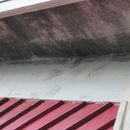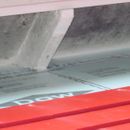Looking for anyone that can explain why mold occurred on the bottom side of the roof deck overhang, between the rafter tails.
It is an open overhang, so no soffit. Black roof. The mold is on the back side of 3/4″ exterior plywood which replaced original 80 year old deck 11 years ago. This playwood was painted with oil based Sikkens Rubbol DEK. This mold is occurring on all orientations of the house. It is a gambrel roof, dutch colonial style. A detached garage with the same style overhang has the original wood deck and has no mold. I originally thought that the sun was driving water vapor slowly through the shingles, wood deck and it condensed on the back side.
GBA Detail Library
A collection of one thousand construction details organized by climate and house part











Replies
would help to know if mold is surface only or also within sheathing; we know mold needs moisture & food; seems to like your coating; condensation on warm side of cold surface; what is condition inside attic ? is this just a continuation of what's going on beyond the soffits?
My 1st guess would be that the mold is feeding off the oils & additives of your paint ... when using an oil based paint on the exterior, a mildicide should be added ... was one?
Are you in a high humidity location?
Probably a combination of warm moist air leaking out of the attic and condensing on the underside of the roof deck, AND a wood finish that has mold food in it. Oil finishes often seem more suspect to me, but I've seen it on acrylic. This could be in combination with heat/air moving through/out of the walls and windows. I would tend to think the garage isn't showing the same due to lack of anyone living in there, so there's less heat and moisture.
No mildicide was used. Not a high humidity location. I think David Meiland's answer is right. and I'm working to identify even more house to attic air leaks which are I think contributing to this problem. It may all have been due to or at least started when my father lived with us in the last year of his life, before eternity. We had to run an oxygen concentrator which also humidified the air for him as well. Inside house RH therefore ran 45% that Wisconsin winter... not a good set of conditions! Also hadn't done much of my air sealing yet.